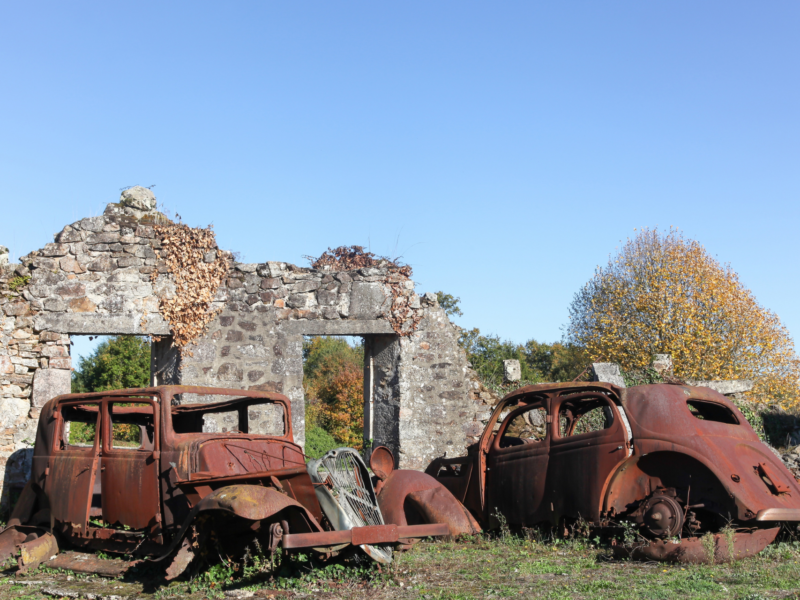Imagine a village frozen in time, its streets silent and homes empty, a haunting reminder of a day that forever changed its destiny. This is the story of Oradour-sur-Glane, a small village nestled in the heart of France. Once a bustling small village, today it stands as a poignant symbol of the horrors of war. But what happened here? Why does this village look as if time has stood still? Follow us on this journey as we go back in time to uncover the tragic history of Oradour-sur-Glane. So, buckle up, as we delve into the story of a village that time forgot, but history remembers.
Before the echoes of war reached its doorstep, Oradour-sur-Glane was a peaceful village nestled in the rolling countryside of central France. The village was a picture of rural tranquility and charming stone houses. However, as the 1940s dawned, the world outside was changing rapidly.
The Second World War had engulfed Europe, and by 1944, the conflict was at its peak. The Normandy landings, known as D-Day, had just taken place on June 6, marking a significant turning point in the war. Little did the villagers of Oradour-sur-Glane know that just four days later, their lives would be irrevocably altered, their peaceful village destined to become a symbol of the senseless brutality of war.
The Horrors of June 10, 1944
June 10, 1944, marked a fateful day for the people of Oradour-sur-Glane. The village was in the German-occupied zone of France during the war. As World War II raged on, a detachment of the Nazi SS Division arrived in the village.
Under the guise of conducting an identity check, the troops herded the unsuspecting villagers into the market square. The villagers were separated by gender; the men were ushered into barns on the outskirts of the village, and the women and children were confined within the village church.
What followed was a chilling display of brutality. The barns were set ablaze, and grenades were hurled through the windows of the church. Any desperate attempts to escape were met with a hail of bullets. By the end of the day, a total of 642 innocent lives had been lost—almost the entire population of the village. The soldiers then pillaged the empty homes before reducing the village to ashes.
Preserving the Memory
In the aftermath of the massacre, the French government faced a difficult decision—to rebuild Oradour-sur-Glane or to preserve it as a memorial to the victims. It was decided that the village would become a national memorial site. It was left untouched, frozen in its post-attack state, serving as a permanent reminder of the atrocities committed. The ruins of Oradour-sur-Glane are prominent in the French national memory of World War II.
Visiting Oradour-sur-Glane
Today, the ruins of Oradour-sur-Glane are meticulously preserved by the Ministry of Culture, sprawling across an expansive 40 acres. Visitors are able to visit the ruins of the village, which have been untouched since World War II. Oradour-sur-Glane holds a unique position in Europe as the only fully preserved, ruined village that bears the scars of the most devastating Nazi massacre of civilians on French soil.
As you wander through the village, it’s as if you’ve been whisked back in time. The eerie silence that shrouds the deserted streets and decaying buildings is a poignant reminder of the lives that were lost.
Remembering the Victims
In addition to its physical preservation, Oradour-sur-Glane also serves as a memorial to the victims. The Centre de la Mémoire, located near the village, provides a comprehensive account of the events that transpired on that fateful day. Through photographs, personal testimonies, and artifacts, the center ensures that the memory of the victims remains alive and that their stories are not forgotten.
Unfortunate Acts of Vandalism
Regrettably, in 2020, the memorial site was vandalized with graffiti. “Images of an inscription at the site in the village of Oradour-sur-Glane show the word “martyr” in the text “martyr village” replaced with “liar.“
The defacement of the memorial was met with widespread condemnation from French politicians and the government. The French Interior Minister expressed his indignation, describing the act of vandalism as “spitting on the memory of our martyrs.” This incident, met with public outrage, underscored the need for enhanced measures to protect the site, a silent witness to one of the darkest chapters in French history.

“Traveling is the art of collecting stories, not just souvenirs.”
